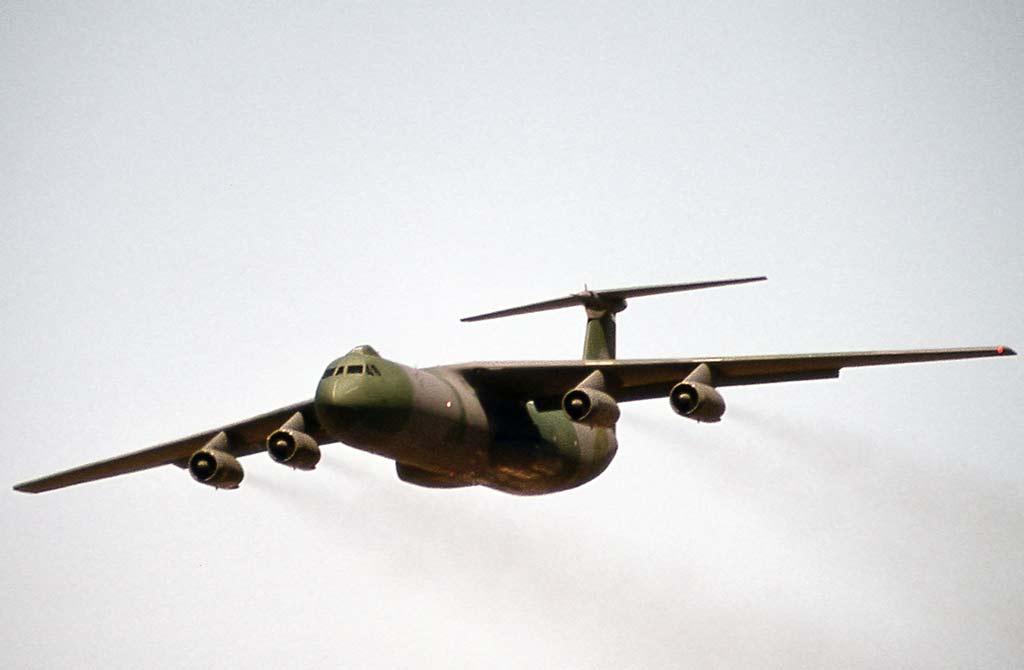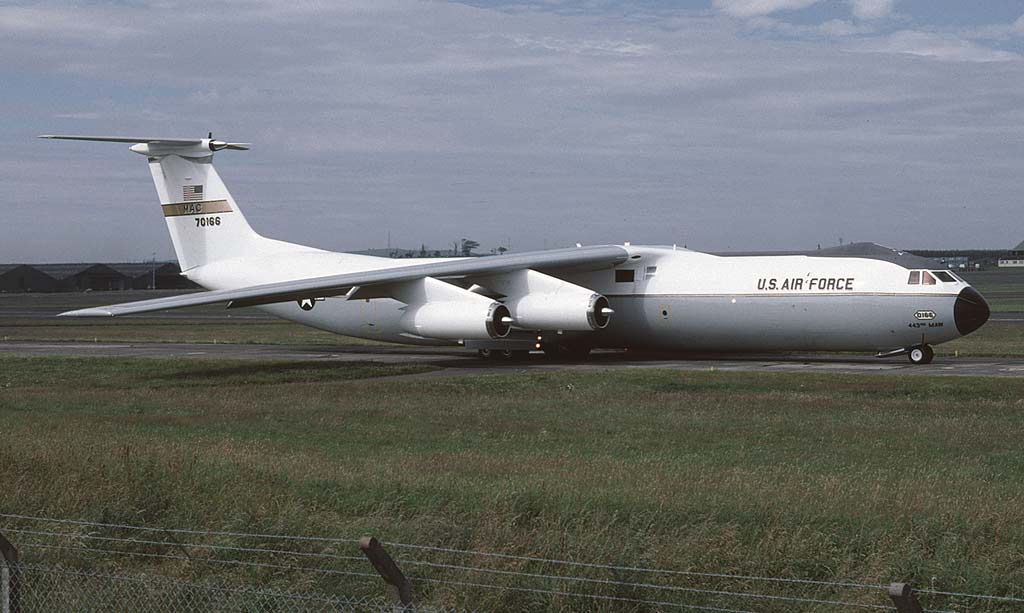A strategic airlifter, the C-141 Starlifter served as a core asset for USAF, enabling rapid global military logistics with its considerable payload capacity.
In brief
The Lockheed C-141 Starlifter, a military strategic airlifter, was developed by Lockheed Corporation. Primarily used by the United States Air Force, it provided essential airlift capabilities, including troop movement, cargo transportation, and aeromedical evacuation. The aircraft featured four turbofan engines, a high-wing design, and a distinctive T-tail, optimizing it for long-range, high-capacity missions. Its design allowed for rapid loading and unloading, facilitating efficient operational turnarounds. The C-141 underwent significant upgrades throughout its service, enhancing its range, payload, and versatility, marking it as a pivotal asset in strategic airlift operations.

History of the Development of the Lockheed C-141 Starlifter
The era of the 1960s demanded a revolutionary approach to military airlift capabilities, driven by the escalating Cold War tensions and the increasing U.S. military commitments worldwide. The existing fleet, primarily propeller-driven aircraft, was inadequate for the fast-paced, global reach required by the United States Air Force (USAF). This led to the initiation of the C-141 Starlifter program, aimed at developing a jet-powered airlifter that could fulfill the strategic needs of rapid troop deployment and cargo transportation across vast distances.
The Lockheed Corporation was awarded the contract to develop this new aircraft, capitalizing on its extensive experience in aerospace engineering. The development was marked by a swift progression from design to reality, reflecting the urgent military need. The C-141 first took to the skies on December 17, 1963, symbolizing a significant leap in air mobility for the USAF. The aircraft was designed without a specific NATO nickname, focusing instead on its functional prowess.
The design and development of the C-141 were heavily influenced by the geopolitical and military requirements of the time. It was a period characterized by the necessity for rapid global response and the ability to project military power across continents. The Starlifter was conceived to meet these needs, offering a solution that significantly surpassed the capabilities of earlier transport aircraft. Its development was a response to the strategic imperative for swift, efficient, and flexible airlift capacity, enabling the USAF to fulfill its global commitments more effectively than ever before.
Design of the Lockheed C-141 Starlifter
The Lockheed C-141 Starlifter showcased a high-wing, T-tail design, optimizing stability and cargo-loading efficiency. Its length spanned 168 feet (51.2 meters), with a wingspan of 160 feet (48.8 meters), and a height of 39.3 feet (12 meters), accommodating substantial cargo volumes. The aircraft was equipped with a sophisticated cargo handling system, facilitating rapid loading and unloading, pivotal for swift military deployments.
The C-141’s design incorporated four Pratt & Whitney TF33 turbofan engines, ensuring robust thrust and enabling a maximum payload of 70,847 pounds (32,136 kilograms). Its range was a remarkable feature, with the ability to fly 2,935 miles (4,723 kilometers) without refueling, extendable with aerial refueling capabilities. This strategic reach allowed the USAF to operate globally without reliance on ground-based fueling infrastructure.
While the Starlifter was a leap forward, it had its limitations. The initial design lacked in-flight refueling capability and had a limited cargo hold length, restricting the transport of outsized cargo. However, subsequent upgrades, including the C-141B Stretch modification, addressed these issues, significantly enhancing operational flexibility and cargo capacity.
The Starlifter’s design was instrumental in advancing military logistics, providing the USAF with an airlift asset that combined speed, capacity, and range, transforming the nature of strategic airlift in the Cold War era and beyond.
Performance of the Lockheed C-141 Starlifter
The C-141 Starlifter’s performance metrics were a testament to its engineering marvel. Equipped with four Pratt & Whitney TF33-P-7 turbofan engines, each generating up to 21,000 pounds of thrust, the aircraft exhibited exceptional power. This enabled a cruising speed of 500 mph (805 km/h) and a service ceiling of 41,000 feet (12,497 meters), ensuring rapid transit across continents.
Its operational range stood at 2,935 miles (4,723 kilometers), a significant figure that allowed for strategic global missions without frequent refueling stops. With in-flight refueling, this range extended further, showcasing the aircraft’s long
-haul capabilities. The Starlifter could carry a maximum payload of 70,847 pounds (32,136 kilograms), illustrating its capacity to transport substantial cargo or a large number of troops and equipment.
Comparatively, the C-141 was among the first of its kind, setting a high standard for subsequent military transport aircraft. Its combination of speed, range, and payload capacity was superior to older propeller-driven aircraft and even some contemporary jet transports, marking it as a powerhouse in strategic airlift.
Variants of the Lockheed C-141 Starlifter
The Lockheed C-141 Starlifter featured two main variants: the original C-141A and the upgraded C-141B. The C-141A was the initial model, renowned for its strategic airlift capabilities. However, it soon became apparent that increased capacity was necessary, leading to the development of the C-141B. This variant underwent a “Stretch” modification, which included lengthening the fuselage by 23 feet (7 meters) and adding in-flight refueling capabilities, significantly enhancing its operational range and flexibility.
Another notable variant was the C-141C, which incorporated modern avionics, improved navigation systems, and enhanced communication equipment, ensuring the aircraft remained viable in modern airspace well into its later years of service.

Military Use and Combat of the Lockheed C-141 Starlifter
The Lockheed C-141 Starlifter was a linchpin in U.S. military operations, especially noted for its extensive use in Vietnam, where it facilitated rapid troop deployments and the expeditious delivery of supplies. Its role extended beyond Vietnam, participating in numerous military, humanitarian, and disaster relief operations worldwide, demonstrating its strategic importance.
The aircraft did not carry armaments; its design focused on cargo and troop transport. It played a crucial role in missions like Operation Nickel Grass during the Yom Kippur War, delivering critical supplies to Israel. In the later stages of its service, it was pivotal in operations Desert Shield and Desert Storm, showcasing its capability to operate in conflict zones effectively.
The Starlifter’s operational history reflects its strategic significance, with no direct competitors at its inception. It was eventually succeeded by the C-17 Globemaster III, which offered enhanced capabilities, such as the ability to operate from shorter runways and carry larger payloads.
As of its retirement in 2006, the C-141 had been completely phased out, with its duties fully assumed by the more advanced C-17, marking the end of an era for this iconic airlifter.
The Lockheed C-141 Starlifter represented a pivotal advancement in military airlift, combining speed, capacity, and range to meet the strategic demands of the United States Air Force. Its introduction marked a significant shift in air mobility, setting the stage for future innovations in military logistics and transport. The Starlifter’s legacy endures, epitomizing the evolution of strategic airlift in the latter half of the 20th century.
Back to Transport planes.